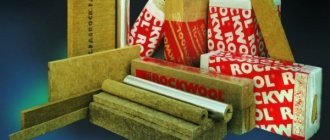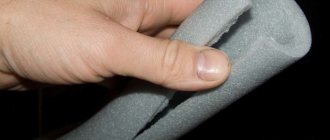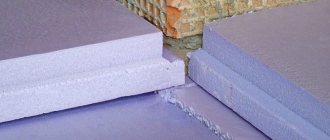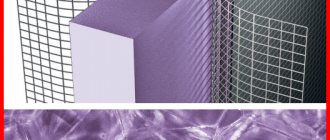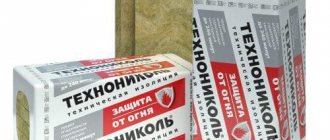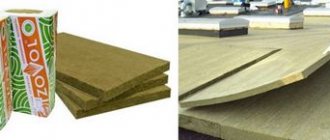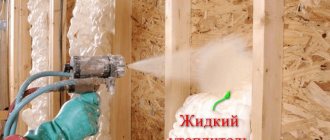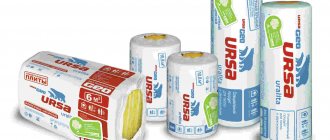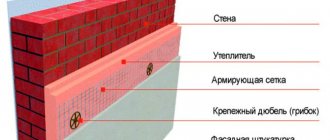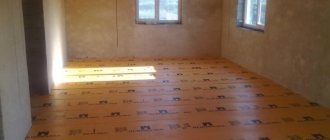Many people in their lives have encountered construction and searching for information about a particular product. This article will focus on a review and comparison of the world-famous Rockwool products.
After reading this article, you will learn:
- What is ROCKWOOL
- You can watch the video: History of the manufacturer ROCKWOOL
- Find out what types of ROCKWOOL insulation there are and where they can be used
- You can familiarize yourself with the summary table of technical characteristics and prices for Rockwool products
- Decide on the choice of insulation to insulate the surface you need.
For those who don't know what ROCKWOOL is
ROCKWOOL is a group of companies that is a leader in the production of stone wool insulation, under the world famous brand “ROCKWOOL”, not only in Russia, but also in Europe, Asia and other continents of the world. Since 1909, it has constantly developed and improved its technologies, thanks to which the manufacturer has launched a diverse line of stone wool insulation materials on the market, which are designed for insulation, sound insulation and fire protection of residential, office, industrial and engineering buildings and structures.
Today , in addition to thermal insulation from stone wool, the ROCKWOOL brand also produces acoustic suspended ceilings, soundproofing barriers against road noise, decorative facade panels and soil substrates for the horticultural industry.
Which insulation is better, Rockwool Scandic Light Butts or Light Butts?
Large construction companies take advantage of the differences between Rockwool Light Butts Scandic and Rockwool Light Butts. First of all, developers appreciate the enlarged slab format. Accelerated completion of work, significant savings on logistics, as well as the possibility of long-term storage of compressed slabs open up great opportunities for improving estimated indicators.
Private teams and homeowners with small volumes of work appreciate the opportunity to buy a small amount of thermal insulation in a pack of Rockwool Light Butts. Lightweight thermal insulation can be perfectly combined in different thicknesses and is used with virtually no residue, as it is applicable for all insulation systems.
This is the main difference between Rockwool Light Butts Scandic and Rockwool Light Butts.
This knowledge simplifies the choice of material for insulating a country house and professional construction. Basalt thermal insulation made from mineral wool fiber is in demand in the construction of multi-storey buildings, private country houses, dachas, domestic and outbuildings of various types. The demands of builders are fully satisfied by the insulation of Rockwool Light Butts and Light Butts Scandic, and the differences help make the right choice for insulating a building with optimal investment. If you have any questions or need advice, dial 8 (495) 212 06 41 for a free consultation. Insulate your home wisely!
ROCKWOOL insulation range
Thanks to modern equipment and the latest production technologies, the ROCKWOOL insulation range includes a dozen types of insulation, which the manufacturer produces in different thicknesses, which allows you to insulate almost various objects and surfaces.
Among them are:
LIGHT BUTTS
LIGHT BUTTS SCANDIC XL 100mm
ACOUSTIC BUTTS
FLOR BUTTS
FIRE BUTTS
SAUNA BUTTS
ROCK FACADE (BUTTS FACADE)
WIRED MAT
TECH BATTS
RUF BUTTS
LIGHT BATTS is the best basalt insulation for private housing construction, which is produced in the form of slabs measuring 1000x600x50mm and 1000x600x100mm.
They are used to insulate : attics, balconies, loggias, frame walls, partitions, floors, roofing and ceilings between floors.
LIGHT BUTTS SCANDIC XL 100mm is a new, most popular and convenient insulation for private housing construction, with an increased size of the slabs. The size of one slab is 1200x600x100mm.
They are used to insulate : attics, balconies, loggias, partitions, floors, ceilings between floors and walls.
ACOUSTIC BUTTS is a specially developed technology for the production of stone slabs in which stone wool fibers are arranged in a chaotic manner, which provides maximum sound insulation effect and helps to provide a sound barrier against ambient noise and very loud human speech.
They are used to insulate : middle layers indoors (partitions in living quarters, ceilings along joists).
FLOOR BUTTS are rigid slabs that are specially designed for thermal insulation of floors, with a load of up to 3 kPa.
They are used to insulate : floors between floors, as well as for laying under cement screeds, heated floors and screeds made of gypsum fiber board and fiberglass board.
FIRE BUTTS are high-temperature stone slabs that are covered with aluminum foil, which allows you to create a reflective effect of heat and avoid heating neighboring structures.
They are used to insulate fireplaces and stoves in private homes, as well as pipeline systems.
SAUNA BUTTS are lightweight heat-resistant plates with foil, on the one hand, which are produced specifically for rooms with high humidity and temperature, where it is important to reduce electricity costs and also maintain heat in the room.
They are used to insulate walls in steam rooms, saunas and baths. Can be used without vapor barrier.
ROCK FACADE (FACADE BUTTS) are moderately rigid thermal insulation boards that are resistant to deformation and retain heat well.
They are used to insulate building facades for subsequent plastering and finishing with siding panels.
WIRED MAT is a technical insulation with stainless wire, which is produced in rolls with and without foil.
They insulate air ducts, high-temperature equipment and pipelines to preserve heat and protect against fire.
TECH BATTS is a line of flat insulation, produced by the manufacturer with different densities, for insulating flat surfaces.
It is used to insulate : technological equipment, vertical and horizontal surfaces, stoves, fireplaces and other flat surfaces.
RUF BATTS are basalt slabs with increased rigidity, which are resistant to mechanical stress and are available in the following rigidity options:
- ROOF BUTTS - 160 kg/m3.
- RUF BUTTS B - 190 kg/m3.
- Roof Butts N - 115 kg/m3.
- Roof Butts S - 135 kg/m3.
- Roof Butts EXTRA - the layers differ in density and are glued together: the outer layer is 210 kg/m3, the inner layer is 135 kg/m3. There is a marking on each side of the mat.
- Roof Butts OPTIMA - layers differ in density and are glued together: outer layer - 200 kg/m3, inner - 115 kg/m3. There is a marking on each side of the mat.
They are used for insulation : roofs, when installing attic floors.
What is the difference between Rockwool Light Butts and Scandic: comparison of properties!
It's time to focus on the features of mineral wool thermal insulation. Each type of material has its own undeniable advantages, which is why their popularity remains unchanged. By developing each new product, the brand confirms its focus on the consumer, which is why Rockwool Light Butts and Light Butts Scandic have differences. Let us now name what they are.
- Modification XL.
Only Rockwool Butts Scandic has an increased length of slabs. This is its main difference and advantage. Large-length insulation boards in vacuum packaging take up less space, which speeds up and simplifies loading and unloading operations by reducing the number of packs.
- Slab format.
This parameter opens our TOP “differences between Rockwool Light Butts and Scandic”! There is also a difference in length and width: Rockwool Light Butts are cut into 1000x600 mm sheets. Rockwool Butts Scandic also has a width of 600 mm, but the length of the mini-plates for the standard modification is 800 mm, and for XL - 1200 mm. The enlarged format of slab insulation is very popular among large developers, as large sheets speed up work on large areas.
- Thickness of the slabs.
Rockwool Light Butts thermal insulation is produced with slab heights of 50 and 100 mm, but Rockwool Scandic is available in insulation heights of 50 mm, 100 and 150 mm. This gradation in thickness simplifies the choice of thermal insulation for two-layer insulation, which is very popular when insulating roofs and facades.
- Compression.
This is an important indicator for mineral wool slabs of light thermal insulation. The level of compressibility is the main difference between Rockwool Light Butts and Scandic. For Light Batts the compression is only 30%, but for the Scandic modification it is almost 70%. Read on to find out what opportunities this feature of the miniplate provides.
- Package.
The compression property of miniplates is advantageously used for transportation. Scandic mineral wool insulation compresses almost 2.5 times better than its brother RockwoolLight Butts. That is, after opening a vacuum pack of compressed Scandic, its volume increases significantly. This means that in one transport trip you can carry 3 times more thermal insulation than conventional materials with a low level of compression. Savings on logistics are obvious!
- Price.
A significant difference between Rockwool thermal insulation. With one thickness of 50 mm, Rockwool Light Butts slabs 1000x600 mm will fit in 10 pieces, while the covered surface area will be 6 m2. Almost the same area can be covered, or rather 5.76 m2, with smaller mini-slabs Light Butts Scandica 800x600 mm, of which there will be as many as 12 slabs in a smaller package. A pack of the latter is cheaper.
Here are the main points that distinguish Rockwool Scandic from Rockwool Light Butts. All other parameters: flammability group, thermal conductivity, vapor permeability and water-repellent properties are absolutely identical. You can verify this by looking at our comparison table.
Table of technical characteristics and prices for Rockwool insulation (prices are current as of 02/01/16)
| LIGHT BUTTS SCANDIC* | LIGHT BUTTS* | ACOUSTIC BUTTS* | FLOR BUTTS* | FIRE BUTTS* | SAUNA BUTTS* | BUTTS FACADE* | WIRED MAT* | TECH BATTS* | RUF BUTTS* | |
| Density (types, separated by commas), kg/m3 | 30 | 35-37 | 45 | 125 | 100 | 40 | 145 | 50, 80, 105 | 90, 110 | 115, 135, 160, 190 |
| Thermal conductivity, W/(m K), λ10 | 0,036 | |||||||||
| Thermal conductivity, W/(m K), λA | 0,042 | |||||||||
| Thermal conductivity, W/(m K), λB | 0,045 | |||||||||
| Peel strength of layers, kPa | from 4 to 15 depending on the type of insulation* | |||||||||
| Compressive strength at 10% deformation, kPa | from 20 to 65 depending on the type of insulation* | |||||||||
| Vapor permeability, mg/m h Pa | 0,3 | |||||||||
| Water absorption, no more than kg/m² | 1 | |||||||||
| Service life more than 50 years | Yes | |||||||||
| Flammability degree | NG | |||||||||
| Types of construction insulate: | ||||||||||
| attics | + | + | ||||||||
| balconies | + | + | ||||||||
| loggias | + | + | ||||||||
| frame walls | + | + | ||||||||
| partitions | + | + | + | |||||||
| floors | + | + | ||||||||
| roofing | + | + | ||||||||
| floors between floors | + | + | ||||||||
| ceilings with joists | + | |||||||||
| ceilings between floors, under cement screed | + | |||||||||
| fireplaces, stoves, high-temperature equipment | + | + | + | |||||||
| piping systems, air ducts | + | + | ||||||||
| walls in steam rooms, saunas, baths | + | |||||||||
| building facades | + | |||||||||
| vertical and horizontal surfaces | + | |||||||||
| roofing | + | |||||||||
| Price per package, rub (thickness 50 mm) | 475 | 598 | 733 | 761 | 2781 (30mm) | 682 | 796 | 1230 | 925 | 955 |
* - You can always find detailed information and current prices in the Rockwool product catalog.
Rockwool Light Butts
Rockwool has released a new product. This is an updated version of the famous Light Butts thermal insulation. It is used for insulation and soundproofing of attics, pitched roofs, balconies, baths and saunas.
The new product is produced using Flexi technology, where the Light Butts plate has a springy edge. That is, unlike similar materials on our market, the new product has spring on one side. The spring makes the insulation process very simple. To install Light Butts thermal insulation slabs, you need to slightly press the slab and insert it into the frame. In the design, the plate will straighten and fit tightly between the guides.
With the help of Light Butts technology, the house will maintain a comfortable temperature and there will be no drafts. The new product does not need to be trimmed to the exact size of the frame, so the number of trims and steps will be reduced.
The packaging of Rockwool Light Butts has also changed; it has become more informative. In addition to the Rockwool logo, the product name appears on it, the scope of application and main characteristics are indicated. This will simplify the purchase of thermal insulation in a store or market. It is important that the price is equal to the cost of the previous product.
Rockwool Light Butts thermal insulation with Flexi technology is used not only in the process of new construction, but also in reconstructions and repairs of existing structures. The slabs have a sealed package made of durable film and are completely closed on all sides, thereby protecting the products from mechanical damage during transportation and precipitation during storage. Main Application:
- partitions and ceilings
- balconies, saunas and baths
- walls (frame and with siding)
- curtain wall systems (inner layer)
- pitched roofs and attics
Technical characteristics of Light Butts
| Parameter | Meaning |
| Density, kg/m3 | 37 |
| Thermal conductivity, W/Mk, ?10 | 0,036 |
| Thermal conductivity, W/Mk, ?25 | 0,038 |
| Thermal conductivity, W/Mk, ?A | 0,040 |
| Thermal conductivity, W/Mk, ?B | 0,042 |
| Compressibility, no more than, % | 30 |
| Vapor permeability, not less, mg/(m h Pa) | 0,30 |
| Acidity module | 2.0 |
| Flammability group | NG |
Light Butts slabs are lightweight; Thermal insulation Rockwool Light Butts is hydrophobized and non-flammable; Products are made from stone wool based on basalt rocks; The slabs are produced in sizes 1000*600 mm; The thickness of Light Butts thermal insulation can be from 50 mm to 200 mm, with increments of 10 mm;
An example of the use of Rockwool Light Butts mineral wool:
One side of the Light Butts packaging has a product description, the other the ROCKWOOL logo
Hermetically sealed product packaging allows the material to be stored outdoors
After opening the package, protect the slabs from exposure to precipitation
Laying mineral wool slabs in the floor structure
Light Butts mineral wool boards are covered with plywood
To reflect heat, we place penofol on the plywood.
We cover our insulated floor with a laminate finish
We fasten the baseboards and our heated floor is done
Light Butts in this design has not only good thermal insulation properties, but also excellent sound insulation
Our floor is insulated and, most importantly, has acquired an aesthetic appearance!
(The pictures show one of the options for floor insulation in a country house)
Buy Rockwool Light Butts
+7,
This might be interesting:
| |
| |
| |
| |
|
LLC GC "TEPLOSILA" - together with you since 2005!
